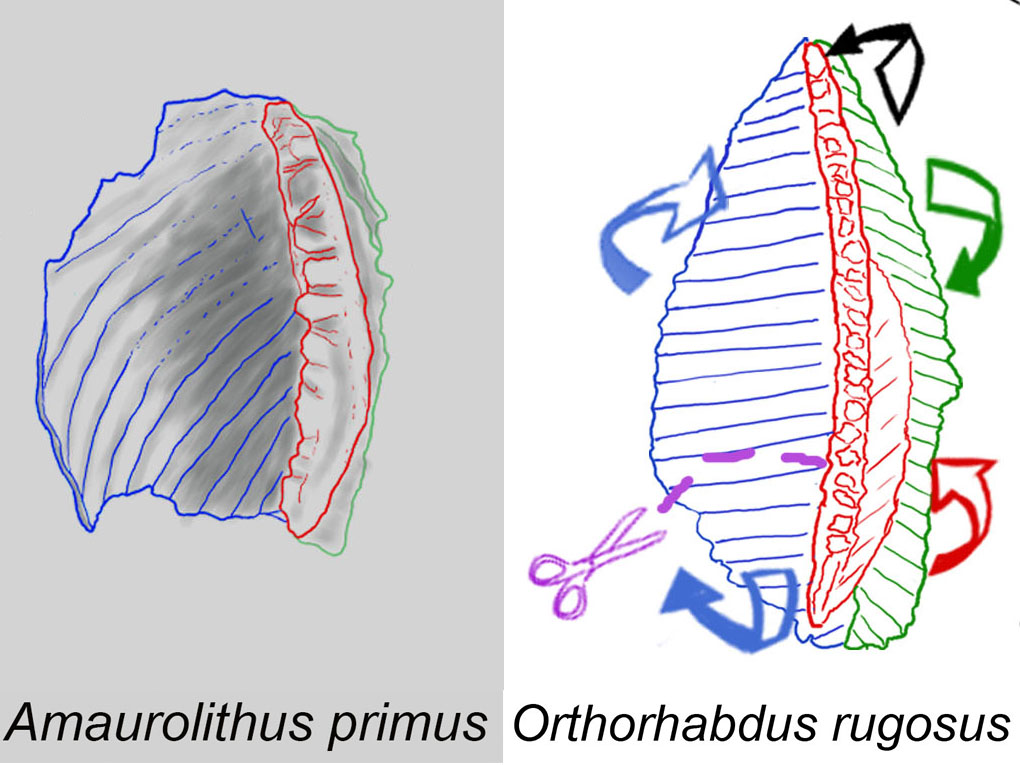Home » Nannofossils
Category Archives: Nannofossils
Origin and evolution of the Neogene calcareous nannofossil Ceratolithus
Sediment samples of deep marine oceanic ODP boreholes from sites 999 in the Caribbean Sea and 1237 in the Eastern Pacific Ocean covering the period between 6 and 4.5 Ma have been studied with a focus on ceratolith evolution. Orthorhabdus rugosus is a nannolith with three blades (sinistral, median, and dextral) that first appeared during the Serravallian, it is not-birefringent in its stable orientation. It shows a high morphological variability time-interval at the end of the Messinian to the basal Pliocene (5.5 to 5 Ma) during which Ceratolithus (5.484 Ma) evolved. Changes occurred in the sinistral and median blades, whilst the dextral blade was reduced. Ceratolithus finifer n. comb is the first species of the evolutionary line. The nannolith stable position changed during its evolution, resulting in the older forms showing low birefringence and the younger ones moderate to high birefringence in the most stable orientation. Ceratolithus acutus, with an arrowhead shape, Ceratolithus armatus, and the morphologically distinct C. larrymayeri evolved from C. finifer with all three species showing high birefringence. The previous O. rugosus and C. finifer continued. Finally, C. armatus gives rise to C. cristatus. Ceratolithus atlanticus and C. tricorniculatus also evolved from C. finifer. All the species mentioned become extinct during the Pliocene except Ceratolithus cristatus that lives today. Detailed observations permit the analysis of the evolutionary trends of the group, possible mechanisms, patterns, and processes of speciation, and establish new criteria to define the species that, by their relative abundance and short geologic range, have permitted adjustment of biostratigraphic markers for this period.

Cite as: Lancis, C., Tent-Manclús, J.-E., Flores, J.-A., 2024. Origin and evolution of the Neogene calcareous nannofossil Ceratolithus. Mar. Micropaleontol. 186, 102310. https://doi.org/https://doi.org/10.1016/j.marmicro.2023.102310
Evolution of Amaurolithus: Amaurolithus delicatus marking the Messinian bottom
After a complete study of the sediment samples from Ocean Drilling Program (ODP) Sites 999 and 1237 in the Caribbean Sea and Eastern Pacific Ocean in order to monitor the evolution of ceratoliths. The First Occurrence of Amaurolithus delicatus marks the bottom of the Messinian Stage. The first ceratholith, A. primus, has two arms and a horseshoe shape with marked laths, and is stable and concave upwards having three blades (sinistral=blue, median=red, and dextral= green).
Early robust A. primus evolved into stylised forms and then to Amaurolithus delicatus (7.226 Ma), an almost plain horseshoe ceratolith with two arms. The left arm, usually the longer one, comes from the sinistral wing of A. primus and has a characteristic flattened omega section (Ω) without laths. There is a distribution overlap between A. primus and A. delicatus; the highest occurrence of the first one, at 6.282 Ma, is a newly proposed bioevent for the Messinian. After this, Amaurolithus does not have laths on its longer left arm and should be included in A. delicatus.

Cite as: Lancis, C., Tent-Manclús, J.-E., Flores, J.-A., 2022. Origin and evolutionary trends of the Neogene genera Amaurolithus and Nicklithus (calcareous nannofossils). Mar. Micropaleontol. 175, 102156. https://doi.org/https://doi.org/10.1016/j.marmicro.2022.102156
Origin of the ceratolith genus Amaurolithus
Sediment samples from Ocean Drilling Program (ODP) Sites 999 and 1237 in the Caribbean Sea and Eastern Pacific Ocean were studied to monitor the evolution of ceratoliths from 7.4 Ma to 6 Ma. Orthorhabdus rugosus shows high variability at the end of the Tortonian to the Early Messinian (7.35 Ma to 6.91 Ma), resulting in the Amaurolithus (7.354 Ma) and Nicklithus branches (6.985 Ma). Orthorhabdus rugosus is an ortholith with three blades (sinistral, median, and dextral). The first ceratholith, A. primus, has two arms and a horseshoe shape with marked laths, and is stable and concave upwards. Its sinistral arm is formed from the sinistral blade of Orthorhabdus rugosus and the right arm is formed from the other blades.
The sudden appearance of A. primus in the sedimentary record at around 7.35 Ma was observed in both studied sections . The Figure shows the set modifications of O. rugosus producing the early A. primus. The modifications are not a gradual evolutionary sequence of intermediate progressively modified forms but occur simultaneously as they are present from the beginning of the first recorded specimens. Amaurolithus primus coexisted with the O. rugosus ancestor in the studied samples.

Cite as: Lancis, C., Tent-Manclús, J.-E., Flores, J.-A., 2022. Origin and evolutionary trends of the Neogene genera Amaurolithus and Nicklithus (calcareous nannofossils). Mar. Micropaleontol. 175, 102156. https://doi.org/https://doi.org/10.1016/j.marmicro.2022.102156

Recent Comments